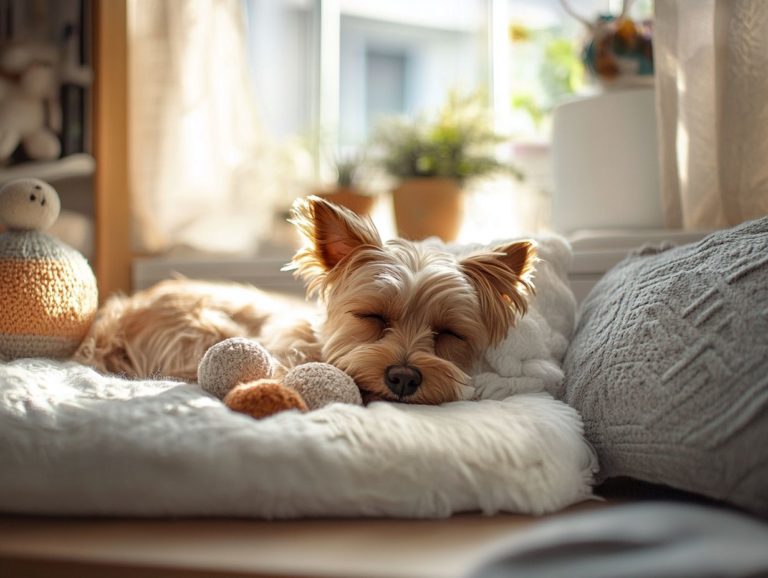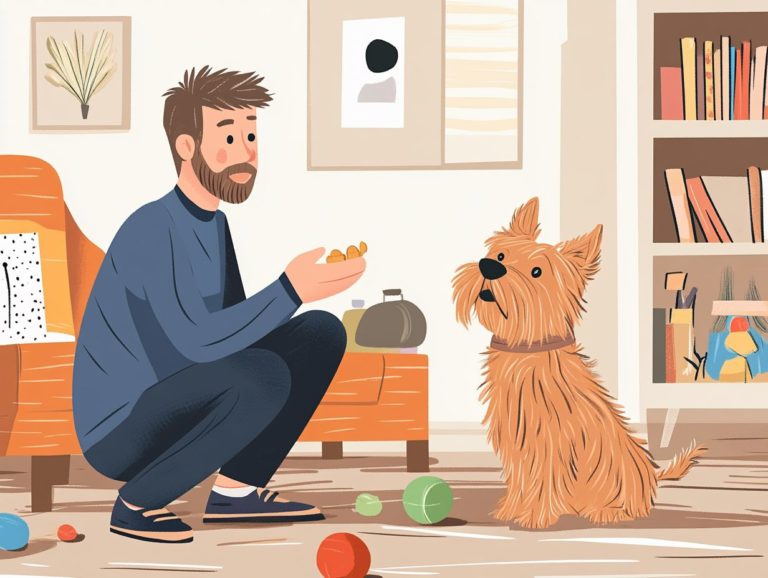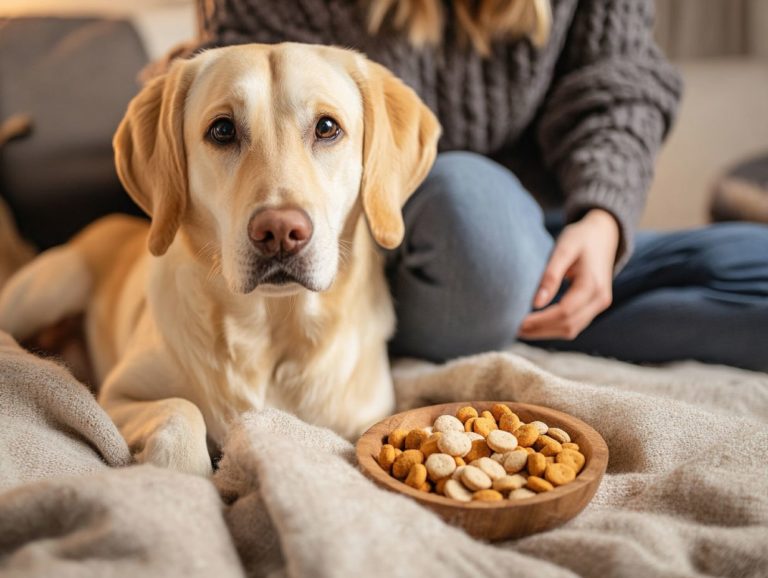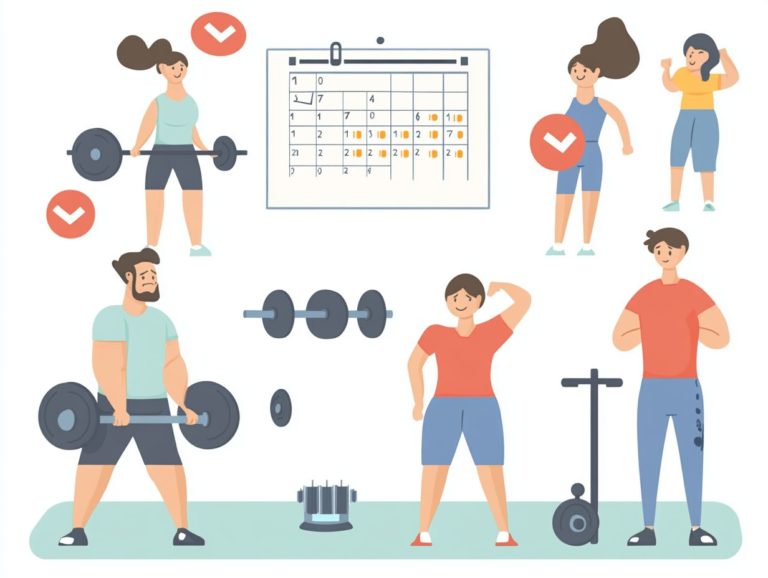Canine Massage Techniques for Anxious Dogs
Are you seeking ways to enhance your dog’s physical and mental well-being? Dog massage might just be the solution you’ve been searching for.
This gentle practice is effective in easing tight muscles and discomfort, and it works wonders in soothing anxious pups.
Uncover the myriad benefits of dog massage, recognize the signs of anxiety in dogs, learn effective massage techniques, and discover tips for creating a calming energy.
Your furry companion deserves that extra layer of love and care let s dive into how you can provide it through home massage!
Contents
Key Takeaways:
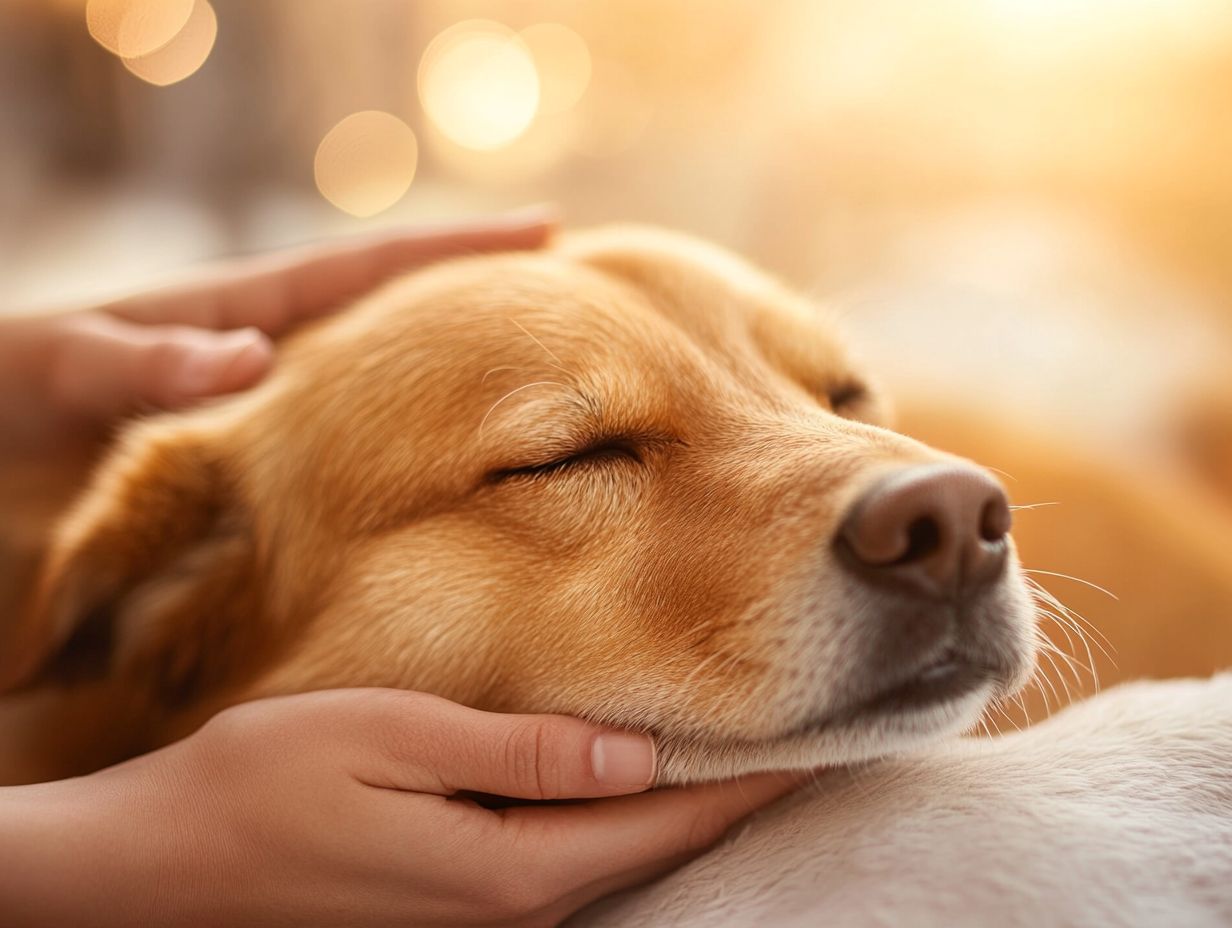
- Massage can improve both the physical and mental well-being of anxious dogs, helping them relax and feel more at ease, particularly through mental comfort.
- Understanding the causes and symptoms of dog anxiety helps you choose the right massage technique for your dog.
- Calming strokes, targeted pressure points, and a relaxing environment are key in alleviating anxiety and promoting stress reduction in dogs.
The Benefits of Dog Massage
Dog massage offers amazing benefits that your furry friend will love! This therapeutic technique excels at managing soft tissues and muscle tension, providing remarkable pain relief and boosting circulation.
Not only does dog massage promote improved mobility, but it also addresses behavioral issues by fostering a calming energy that can effectively alleviate stress and anxiety. Whether your dog is a senior in need of gentle therapy or a lively puppy requiring early intervention, consulting with a qualified dog massage therapist, such as Dr. Sarah Blotevogel from Pawsitive Touch Canine Therapy in Tulsa, Oklahoma, can be invaluable for your dog’s overall health.
Improving Physical and Mental Well-being
Improving both the physical and mental well-being of dogs is a primary goal of dog massage therapy. This holistic approach alleviates muscle tension and aids in injury recovery while enhancing your dog’s overall emotional health.
By employing specific techniques that concentrate on pressure points and muscle groups, dog massage helps release accumulated physical tension that can lead to behavioral issues like anxiety and aggression. If your dog barks excessively or displays destructive behaviors, it may be a sign of underlying stress that targeted massage can address. Additionally, using effective commands for calming anxious dogs can further help alleviate their stress.
This not only calms your pup but also fosters a deeper bond between you and your dog, creating a more harmonious living environment. Incorporating regular massage sessions can help your dog feel more relaxed during stressful situations, such as visits to the vet or encountering unfamiliar environments.
Understanding Dog Anxiety
Understanding dog anxiety is essential for you as a pet owner, as it can significantly affect your dog’s emotional well-being and behavior.
A variety of factors contribute to this condition, revealing signs that call for timely intervention and effective relief strategies.
Causes and Symptoms of Anxiety in Dogs
The causes of dog anxiety can be quite diverse, ranging from environmental factors to underlying health issues. Recognizing the symptoms is essential for effective intervention.
Common signs to watch for include barking, destructive behavior, and noticeable changes in appetite or sleep patterns. Specific triggers like the loud rumble of thunderstorms or the booming crack of fireworks can send many dogs into a panic, prompting frantic attempts to escape or hide.
Routine changes, such as moving to a new home or welcoming a new family member, can also disrupt your pet s sense of security. A prolonged lack of socialization can lead to withdrawal or aggression. These reactions compromise your dog s well-being and can escalate into more serious behavioral problems if left unaddressed.
Dog massage therapy presents a promising solution, allowing anxious dogs to experience physical relaxation while promoting mental comfort. Additionally, techniques to calm anxious pets before training can effectively ease their stress and help restore balance in their lives.
Start massaging your dog today to help them feel relaxed and loved!
Massage Techniques for Anxious Dogs
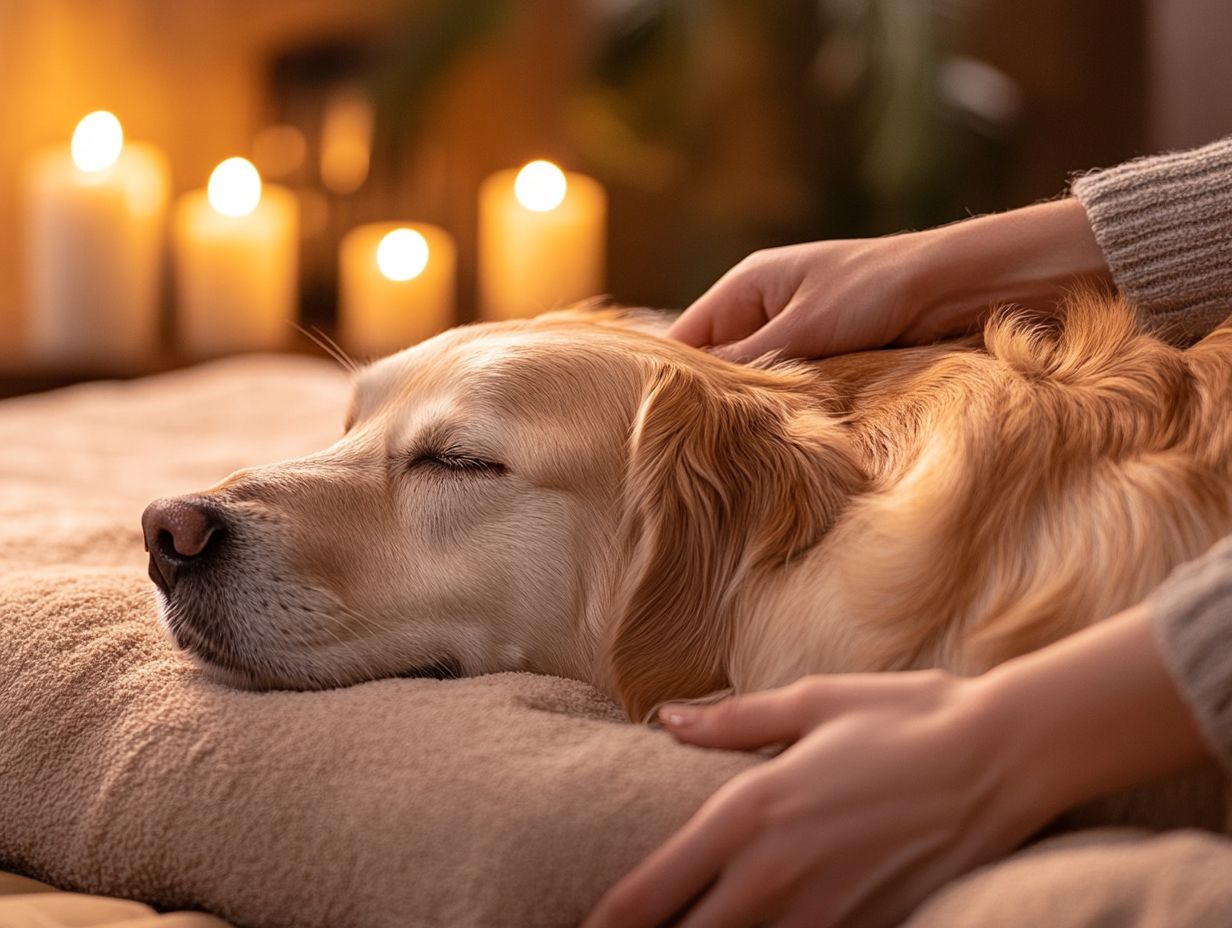
Employing effective massage techniques for your anxious dog is crucial for stress relief.
Gentle, calming strokes and focused pressure on specific points can work wonders in relaxing tense muscles and creating a serene atmosphere.
Calming Strokes and Pressure Points
Calming strokes and pressure points are the foundation of canine massage. These essential techniques, along with techniques for training anxious senior pets, foster relaxation and emotional relief for your dog.
These methods can be tailored to your dog s specific anxiety triggers, helping create a comforting environment that instills a sense of security.
Gently glide your palms along your dog’s spine while applying soft pressure to the major muscle groups to release tension and reduce stress levels.
Focusing on areas like the neck and shoulders with gentle circular motions can alleviate stiffness and improve blood circulation.
Start with light touches and gradually increase the pressure as your dog relaxes. Always pay close attention to your dog s responses and adjust your techniques to ensure a soothing experience for your beloved companion.
Targeting Specific Areas of Tension
Identifying and targeting specific areas of tension is crucial for your dog s recovery and overall well-being.
By recognizing these key spots, you can apply focused massage techniques that alleviate discomfort and promote healing.
To effectively find muscle tension, observe your dog s behavior and posture. Look for signs like reluctance to move, changes in gait, or localized sensitivity.
Techniques like gentle pressing and stretching can help uncover tight spots that need extra care.
You can also use tools like foam rollers or massage balls to enhance your massage. These can provide deeper relief and boost blood flow to affected areas.
Applying warmth or cold therapy before and after the massage can aid in relaxation and reduce inflammation, offering a comprehensive approach to your dog’s muscular health.
Creating a Relaxing Environment
Establishing a relaxing environment is vital for effective canine massage. A tranquil setting nurtures calming energy and promotes stress reduction.
Setting the Mood for Massage
Creating the right mood for your dog’s massage ensures they feel comfortable and secure. Elements like soft lighting and soothing scents play a significant role in establishing a serene atmosphere.
By crafting an inviting space, you not only calm your canine companion but also enhance the overall experience. You might consider incorporating aromatherapy by diffusing essential oils like lavender or chamomile, known for their relaxing properties.
A cozy blanket adds warmth and support, helping your furry friend feel at ease. Choosing a quiet area, away from noise, allows your dog to focus entirely on relaxation.
These simple yet effective adjustments can significantly elevate the calming energy in the room, facilitating a more enjoyable massage experience for your beloved pet.
Start massaging your dog today to see immediate stress relief!
Incorporating Aromatherapy and Music
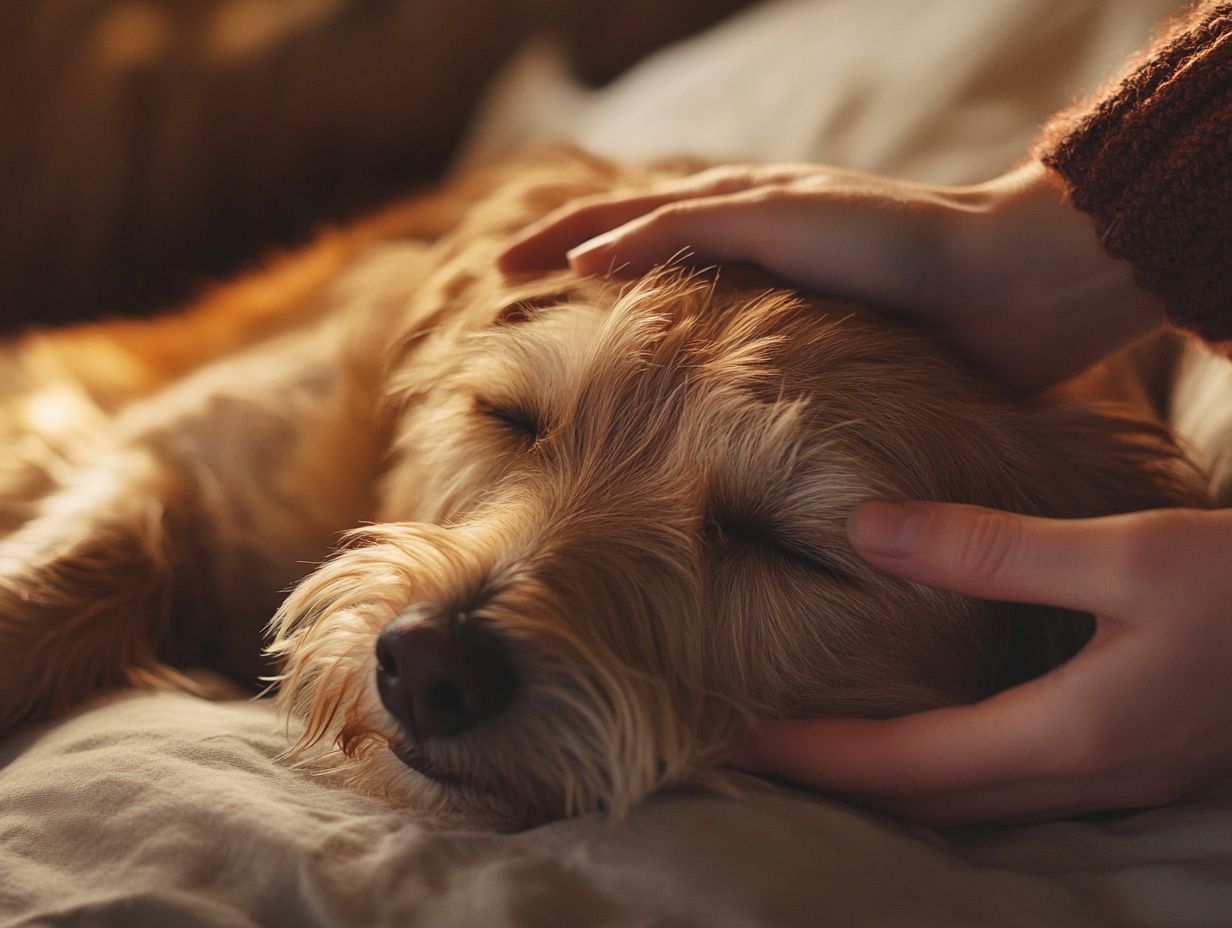
Incorporating aromatherapy and calming music can significantly elevate your dog’s relaxation experience during massage sessions. These elements harmonize beautifully, creating a soothing environment that fosters both emotional and psychological relief.
Essential oils like lavender, chamomile, and cedarwood are particularly beneficial for your four-legged friend. They help alleviate anxiety while cultivating a serene atmosphere. When selecting oils, it s crucial to ensure they are pet-safe, meaning they won t harm your furry companion when used correctly and are diluted appropriately.
Calming scents and specific genres of music such as classical or soft instrumental sounds have proven effective in reducing stress and establishing a tranquil ambiance. By blending the gentle touch of massage with these relaxing aromas and melodies, you can transform an ordinary grooming routine into a luxurious spa experience, nurturing both your dog s body and mind!
Tips for Success
Ensuring your dog s comfort and safety during massage sessions is essential for achieving the best results. By adhering to consistent practices and fostering open communication, you can significantly enhance the experience for both your dog and yourself.
Ensuring Comfort and Safety for Your Dog
Monitoring your dog’s comfort levels during massage is essential to prevent any adverse reactions and foster a positive experience. Always consult your vet for personalized guidance tailored to your dog s specific needs.
Providing soft, comfortable surfaces can significantly enhance the experience, allowing your dog to relax and fully enjoy the benefits of the massage. Applying the right amount of pressure is equally important; varying pressure levels can influence how your dog responds. For dogs with existing health issues, vet supervision is vital to ensure the massage therapy is both safe and effective.
Consistency and Communication with Your Dog
Establishing consistency in your dog massage routines fosters trust and helps alleviate behavioral issues related to anxiety or discomfort. Additionally, implementing noise reduction techniques for anxious pets can create a calmer environment. Engaging in open communication with your dog during these sessions can enhance their receptiveness to the massage.
By crafting a calming environment and using soothing tones, you can set the perfect stage for an enjoyable experience. Pay close attention to non-verbal cues, such as body language and tail position; these subtle indicators can guide you through the process and ensure your dog feels safe and secure.
Incorporating gentle touch techniques can further promote relaxation, transforming each session into a rewarding experience for both of you. Over time, these regular massages will help strengthen the bond between you and your pet, enhancing their overall well-being and emotional health.
Frequently Asked Questions
What are the benefits of canine massage for anxious dogs?
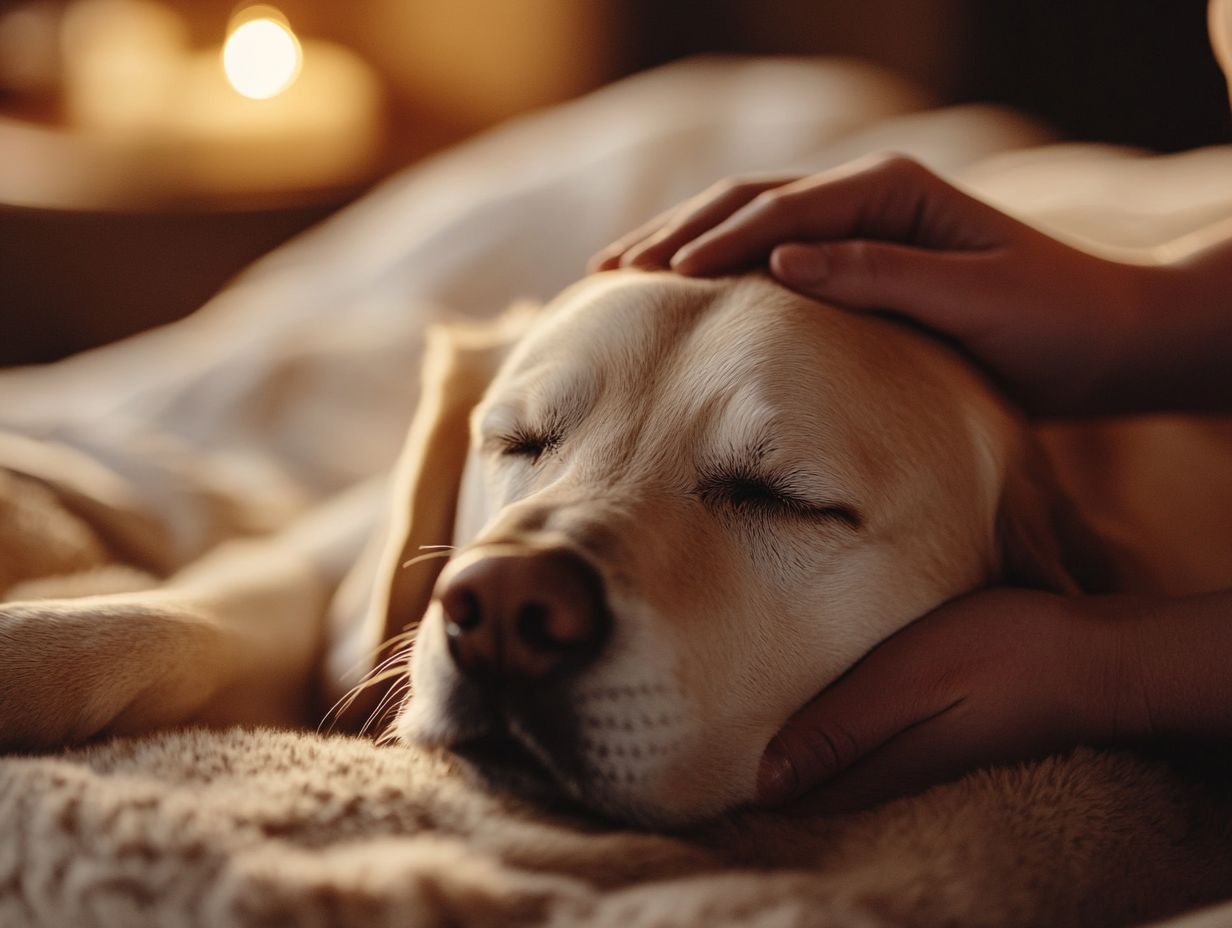
Canine massage can help reduce anxiety in dogs by promoting relaxation, decreasing muscle tension, and increasing the release of endorphins feel-good hormones. For owners of anxious breeds, exploring training techniques specifically for anxious breeds can also be beneficial.
How can I tell if my dog is anxious?
- Excessive barking
- Panting
- Pacing
- Restlessness
- Destructive behavior
- Hiding or becoming withdrawn
What are some common canine massage techniques for anxious dogs?
Common techniques include:
- Long, gentle strokes (effleurage)
- Kneading (petrissage)
- Gentle pressure (compression)
Other techniques may vary depending on the specific needs of your dog.
Is it safe to massage an anxious dog?
Yes, as long as you are gentle and pay attention to your dog’s body language. If your dog shows signs of discomfort or stress, stop the massage and consult a professional.
Start your journey to a calmer pup today!
How often should I massage my anxious dog?
This can vary depending on the individual dog. Generally, 2-3 times a week is recommended.
Always observe your dog’s response and adjust accordingly.
Can I learn how to massage my anxious dog myself?
Yes! You can learn how to massage your anxious dog! There are many resources available, including effective techniques for training anxious puppies, that can help guide you in the process.
It’s best to consult with a certified canine massage therapist to ensure your dog s safety.

